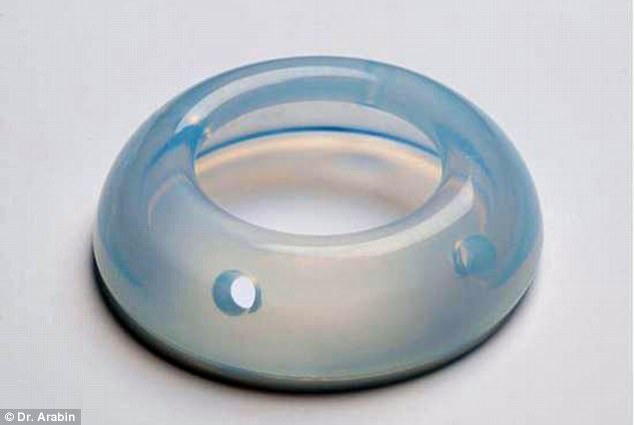A tiny rubber ring halves the risk of having a premature baby, a study suggests.
More than 15 million babies are born prematurely across the world each year – roughly one in 10 of all live births.
Babies born early are at risk of serious problems, including breathing issues, heart problems and learning difficulties.
Now scientists have found that placing a small ring around the cervix half way through the pregnancy slashes the risk of a baby being born very prematurely.
The Italian researchers, from the University of Naples, found high-risk women who received the device were 52 per cent less likely to give birth before 34 weeks of pregnancy than those who did not use the device.
The scientists believe the silicone ring – called a ‘cervical pessary’ – keeps the cervix closed so the baby stays in the womb for longer.
It does this by slightly adjusting the direction of the cervical canal, so the weight of the baby does not force it open too early.
Writing in the JAMA medical journal, they said: ‘The cervical pessary is a silicone device that has been used to prevent spontaneous preterm birth.
‘The leading hypotheses for its mechanism of action are that the pessary helps keep the cervix closed and changes the inclination of the cervical canal so that the pregnancy weight is not directly above the internal [opening].’
How was the study carried out?
The study involved 300 women who were thought to be at risk of having a premature baby because early scans had shown they had a short cervix – a known risk factor.
The women were split into two groups, with half having a cervical pessary fitted at roughly 20 weeks of pregnancy, and the other half carrying on as normal.
The ring was removed at 37 weeks, unless the woman had shown heavy bleeding or other side effects earlier.
Of those who had the ring inserted, only 7.3 per cent gave birth before 34 weeks, compared to 15.3 per cent of those who did not have the device.
The scientists wrote: ‘Use of a cervical pessary, compared with no pessary use, resulted in a lower rate of spontaneous preterm birth at less than 34 weeks of gestation.’
Minor side effects
Women who took part reported only minor side effects.
The scientists said their study had been relatively small, and called for far larger trials to confirm the results.
An editorial by doctors at the University of Utah, published in the same journal, said: ‘Pessaries are an especially attractive treatment because they are relatively inexpensive, are easy to use, can be made widely available, and have relatively few adverse effects.
‘Based on these data, clinicians may contemplate recommending pessaries for all women with a short cervix identified on antenatal sonogram.’
The ring, which costs £45, is sometimes used on the NHS but because until now there has not been much evidence about the device women at risk of early labour are more likely to be treated with a cervical stitch, a procedure that involves stitching tape around the cervix to keep it closed.
The stitch is normally a straightforward procedure, but it does carry a risk of infection, and undergoing the procedure can itself lead to pre-term delivery.
Studies have also raised concerns about the woven thread that is sometimes used in the stitch, which has been linked to stillbirths.
Another approach to delaying childbirth includes giving a daily dose of the progesterone hormone, which has been shown in trials to extend pregnancy.












